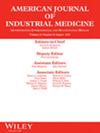Association between longest-held occupation and mortality risk
Abstract
Background
Occupation is associated with a large part of daily activities, affecting lifestyle and social status. However, limited research exists on the association between longest-held occupation (LHO) and early mortality. We examine if LHO is associated with mortality risk among US adults 51 years of age and older.
Methods
Using Health and Retirement Study data from 1992 to 2020, we followed 26,758 respondents 51 years of age and older for up to 29 years. We used competing-risks analysis methodology to estimate the risk of mortality.
Results
Across the average 20.5 follow-up years, women with LHO in the categories of machine operators (subhazard ratio [SHR]: 1.42), food preparation (SHR: 1.39), handlers and helpers (SHR: 1.35), and sales (SHR: 1.15), were more likely to die earlier than women with the LHO in the professional and technical support occupation, the reference occupation. Men with LHO in the categories of food preparation (SHR: 1.43), machine operators (SHR: 1.36), personal services (SHR: 1.34), handlers and helpers (SHR: 1.32), protective services (SHR: 1.31), clerical (SHR: 1.27), farming and fishing (SHR: 1.26), sales (SHR: 1.23), and precision production (SHR: 1.20) had elevated risks of mortality compared to men whose LHO was in the referent professional and technical support occupation.
Conclusions
Findings from this study provide comprehensive and current evidence that occupation can be one of the risk factors for adverse health outcomes and ultimately for early mortality.

 求助内容:
求助内容: 应助结果提醒方式:
应助结果提醒方式:


